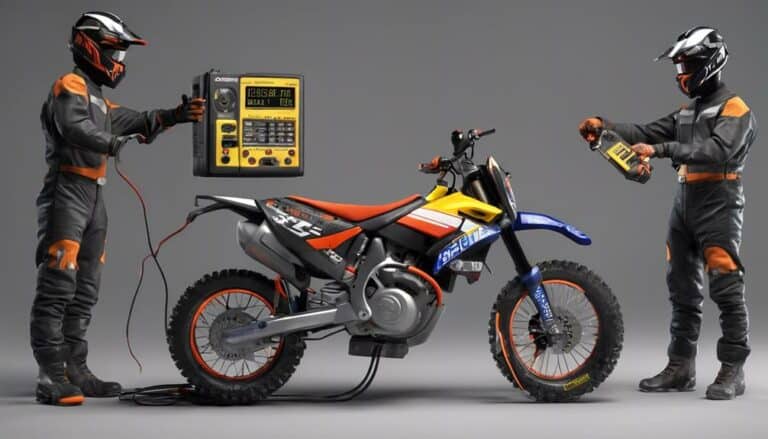To test the battery on your dirt bike for electrical issues, first check the charging system components. Inspect the stator, rotor, and regulator rectifier for proper functioning. Confirm the voltage output is accurate for peak battery health. Regular maintenance is key. Clean battery terminals, screws, clamps, and cables. Look out for corrosion. Use a multimeter to monitor voltage drop and perform a standing voltage test. Understand the significance of battery testing and follow a systematic troubleshooting process. This basic test can help you identify potential issues early on. Mastering these steps can guarantee your dirt bike's electrical system is in top condition.
Key Takeaways
- Check battery voltage with multimeter
- Test for voltage drop during cranking
- Use battery load tester for current draw
- Inspect battery terminals for corrosion
- Ensure strong connections for power efficiency
Understanding Motorcycle Charging System Components
In the motorcycle charging system, the stator and rotor work together to generate alternating current. This alternating current is then converted into direct current by the regulator rectifier to charge the battery on your motorcycle. If any component, such as the stator, regulator rectifier, or wiring, malfunctions, it can lead to issues like battery drainage and electrical problems.
Maintaining the correct voltage output is important for the battery's health. A properly functioning regulator rectifier should provide a voltage output between 14-15 volts to the battery while the motorcycle is running. This guarantees that the battery is being charged effectively and that your electrical system is operating efficiently.
Understanding these key components of the motorcycle charging system is crucial for diagnosing any potential issues related to charging. By grasping how the stator, regulator rectifier, and battery work together, you can troubleshoot and address any charging system problems efficiently, leading to a more reliable motorcycle riding experience.
Testing the Stator for Electrical Issues
Pivoting from the discussion on motorcycle charging system components, testing the stator on your dirt bike for electrical issues involves locating the stator wires and using a multimeter to check resistance. When testing the stator, it is important to look for breaks in the insulation of the stator windings, as these can indicate underlying issues. Additionally, consider performing a dynamic stator test as an alternative diagnostic method to guarantee accurate results. Keep in mind that different dirt bikes may have varying resistance ratings for their stator windings, so refer to your bike's manual for specific values.
| Stator Testing Steps | Description |
|---|---|
| Locate Stator Wires | Find the wires for testing |
| Check Resistance | Use multimeter to measure |
| Inspect Insulation | Look for breaks |
| Dynamic Test | Consider alternative test |
| Reference Manual | Check bike's specifications |
Checking the Regulator Rectifiers Health
To evaluate the health of your dirt bike's regulator rectifier, begin by using a multimeter to test the diodes responsible for rectifying. The regulator rectifier plays a vital role in converting AC to DC and regulating the voltage output to the battery.
While the bike is running, check the voltage output at the battery. A properly functioning regulator rectifier should provide a stable voltage output of 14-15 volts. If the voltage output is incorrect, it could indicate potential issues with the regulator rectifier.
In such cases, inspect the wiring, connectors, and fuses associated with the regulator rectifier to identify any electrical issues. Ensuring the regulator rectifier is in good shape is essential for the best battery performance and overall electrical system functionality on your dirt bike.
Regularly checking and maintaining the regulator rectifier can help prevent future electrical issues and keep your bike running smoothly.
Preventive Maintenance for Optimal Battery Performance
For peak battery performance, routinely inspect and maintain the connections and components associated with your dirt bike's battery. To guarantee top battery performance and prevent electrical issues, follow these preventive maintenance steps:
- Regularly check and clean battery terminals: Clean terminals ensure proper electrical connections, preventing voltage drops and ensuring efficient power transfer between the battery and the bike's electrical system.
- Inspect battery screws, clamps, and cables: Wear or corrosion on these components can lead to poor connectivity, affecting the battery's ability to charge and supply power to the bike. Securely fasten all connections to prevent potential issues.
- Look for signs of corrosion on battery components: Corrosion can hinder the battery's ability to charge and discharge effectively. Use a wire brush to clean any corrosion and ensure a strong connection between the battery and the bike's electrical system.
Troubleshooting Electrical Problems Early
When troubleshooting early electrical problems in your dirt bike, start by performing a standing voltage test using a multimeter for accurate battery voltage measurement. This initial test will provide vital information about the battery's health and overall electrical system.
Monitor the voltage drop during cranking with a cranking voltage test to assess the battery's performance under load conditions. Employ a battery load tester to conduct a current draw test, evaluating how the battery behaves when subjected to varying loads.
Understanding the significance of battery testing is key for peak performance, early issue identification, and ensuring an extended battery lifespan. Follow a systematic process of elimination to diagnose and address potential electrical issues within the dirt bike's battery system efficiently.
Conclusion
Now that you have tested the battery on your dirt bike for electrical issues, you can confidently hit the trails knowing your bike is in top condition.
Remember, maintaining your motorcycle's charging system is like caring for a well-oiled machine – it guarantees smooth operation and prevents breakdowns.
Stay proactive in checking for any signs of trouble, and you'll enjoy many trouble-free rides on your dirt bike.
Happy trails!

